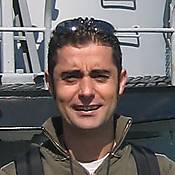I don't know how many of us have had the chance to ride out a storm at sea. During a NATO deployment to the North Atlantic/North Sea during the fall of 1991, I had the extreme pleasure to do such a thing. Since I had read a good deal on the Battle of the Atlantic I recall the sever storms that were mentioned taking place in that area of the world during the fall and winter months.
During our time at sea we had some decent weather. The temperatures were around 40F (4C) most of the time and the seas were running mostly between 10-15 feet(3-4.5m). The ride was rough, but it was easy to live with. Eating was the hardest activity to to. Sitting on the mess decks with the ship rocking and rolling made it hard to keep your tray from hitting the floor. It was also a little hard on your cup of coffee or milk. If you filled a cup it was soon all over your table and on the floor. But with some pointers from the “old salts” everyone adjusted to the ships motion and spills became a thing of the past.
We sailed during the Navies advancement testing period. I did not know I was able to take the test, so I did not bother to study for it, nor did I have all my requirements for the test done. However one week prior to the test I was asked by our engineering officer why I had not taken the military requirements test yet. I told him I was not taking the advancement test so that was why I had not taken the other. Needless to say I had to rush and get everything done so I could take the test next week. Test day came and it was one of the roughest days yet. Instead of nice smooth rolls we were taking short shaky rolls intermixed with some major walk on the walls rolls. Imagine taking an important test like this and your chair keeps sliding around the room.
But, that was not the worst of it yet. We refueled a few times with our regular US oiler and a couple of other times with a British oiler. Each time it was colder and the seas were rougher. The night we crossed the Arctic Circle we refueled with the British. This weather was the worst of the cruise thus far. Not only did we do this at night, but the seas had to be running well over 20 feet (6m) and it was close to or below freezing. Then when two ships get that close they create some serious waves on their own. All this meant somebody was going to get really wet that night. I was topside during the refueling, but my station was not used this night. I had to check our overboard discharge for any signs of fuel. The people on the after fueling station however were not so lucky. The were taking fuel, running samples, and watching the cables. Then the wave none of us wanted happened. I was checking our discharge over the side of the ship when it hit close to me. I jumped back and missed getting covered with water. The crew at the aft station was not so lucky. I heard some them yell over the sound powered phones and knew the had been covered. About ten men were soaked to the bones with seawater in freezing weather.
The big storm happened a few days later when we were leaving Bergen Norway. The ship was delayed in port and our captain was in a hurry to get to our next port in Germany. He had the ship running at flank 2(30knots) out of the fjord. We ran smack into a monster while moving way too fast. Needless to say it was not fun. The ship began to roll, buck, rock, and shake. We all knew it was bad outside, but we had no idea had bad it was going to get. Soon we felt the nose of the ship lurch upward, come down slightly, then go back up. Crashing, breaking, screaming, and sound of falling items sounded all over the ship. A violent shaking followed as the ship came down into the water. Then we heard the engines throttle way back and we began to crawl our way through the storm.
It wasn't until the next morning the full extent of the damage was discovered. We had lost several feet of railing on the forward section of the ship. The brass covers of the capstans were missing, these are big. There cracks all over the superstructure and above all of this the china in the ward room was all broken. One crack was in the top of a fuel tank that forms the bottom of a missile magazine. The helo hangar was effectively broken off the ship and was just sitting on board because it weighed so much. Several of the crew had cuts and bruises from falls. There was also a general messiness from things thrown from their shelves. Old salts claimed this was the worst storm they had been through. Several of the new guys were sick for a day afterward. The bridge crew reported green water over the bow. The rest of us have one heck of a story to pass along. And as they say about sea stories, you can tell its the truth because, I said so up front.




Note missing railing on the left hand side. Also the metal shield around the windlass controls bent.





























